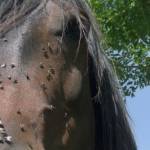Botflies and Horses

In the horse world, botflies are the buzzing, dive-bombing equivalent of bumblebees. But botflies have one-upped bumblebees in one procreative way: they lay eggs. On horses!
Female botflies buzz about their victims, idling in midair long enough to lay eggs. Just where those eggs are laid depends chiefly on the type of botfly. Three species parasitize horse: the common bot (Gasterophilus intestinalis) lays eggs on the horse’s legs, abdomen, flank, and shoulders; the nose bot (Gasterophilus nasalis) drops eggs around the muzzle; and the throat bot (Gasterophilus haemorrhoidalis) deposits its eggs on the underside of the neck and lower jaw. Common bots are most bothersome to horses.
Once botflies lay eggs, mature eggs or fresh-hatched larvae enter the mouth when the horse licks or bites the affected area. They remain in the mouth, usually burrowing in the tongue, gums, or other tissue, for the next month or so, and then molt and migrate to the stomach, where they attach themselves to the stomach lining and remain for 9 to 12 months. Once larvae have fully matured, they detach from the stomach, pass in the manure, and finally develop into flies in soil or dried manure, usually emerging in the summer or fall.
Without proper deworming, horses may develop health problems. Low or moderate infestations are detrimental because bot larvae consume nutrients intended for their host. Severe infestations of bot larvae damage the lining of the stomach, sometimes to the point of ulceration and rupture.
A thoughtful deworming program can virtually eliminate the internal threat caused by botflies. Most deworming preparations contain drugs, known as botcides, effective against bots. Though parasitologists have identified resistance of certain parasites to particular drugs, bots seem to be fully susceptible to currently available anthelmintics.
In addition to deworming, botfly eggs can be removed regularly from the horse’s body by using a sharp-edged instrument known as a bot knife or any number of sandpaper-type implements. Scraping away the eggs ensures they do not gain access to the mouth. Manure management is also integral to botfly control.
In areas where botflies are especially dense, management might reach beyond an effective deworming program. Sensitive horses often take umbrage to the maddening egg-laying techniques of female botflies, including the dive-bomb approach, to the point they will sometimes run or move incessantly to escape the annoyance. This, in turn, could precipitate problems with weight loss. Should this be the case, owners should offer horses shelter and other forms of insect protection.
Weight loss can be quickly overcome, assuming horses are properly managed, through the provision of good-quality forage and an appropriate textured or pelleted feed.








